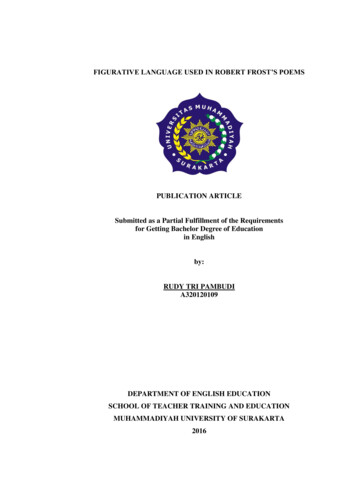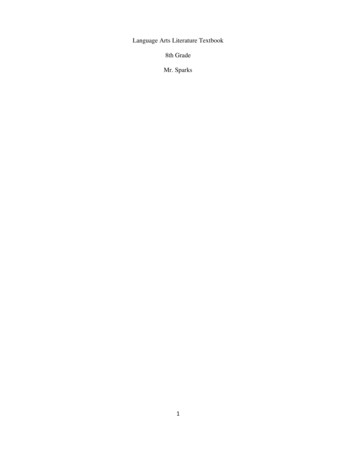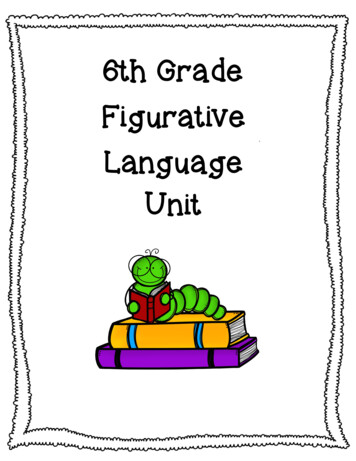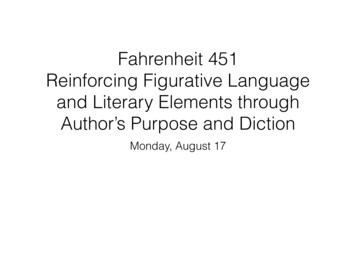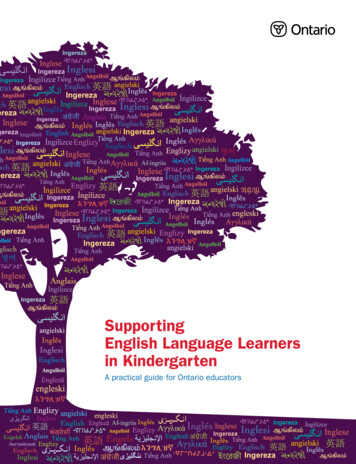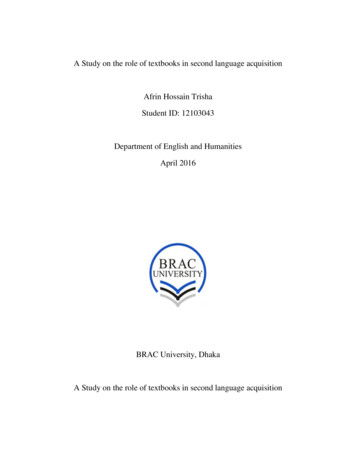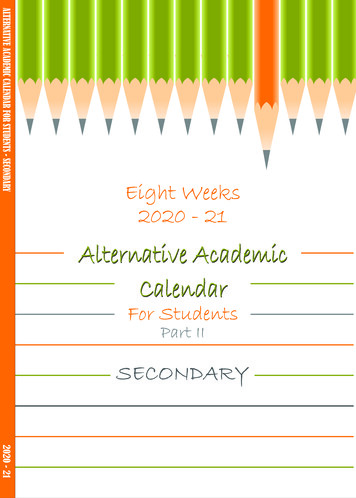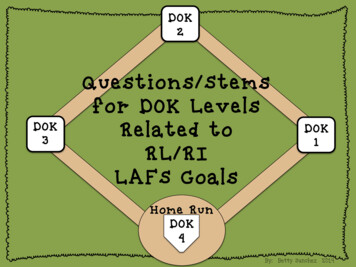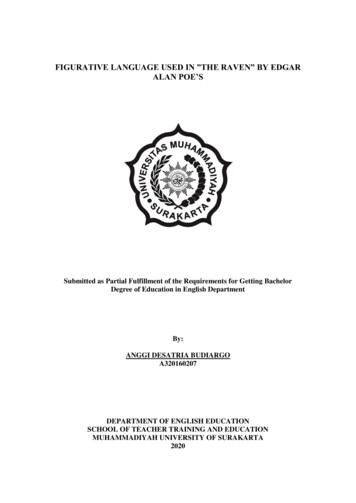
Transcription
FIGURATIVE LANGUAGE USED IN ”THE RAVEN” BY EDGARALAN POE’SSubmitted as Partial Fulfillment of the Requirements for Getting BachelorDegree of Education in English DepartmentBy:ANGGI DESATRIA BUDIARGOA320160207DEPARTMENT OF ENGLISH EDUCATIONSCHOOL OF TEACHER TRAINING AND EDUCATIONMUHAMMADIYAH UNIVERSITY OF SURAKARTA20201
APPROVALFIGURATIVE LANGUAGE USED IN ”THE RAVEN” BY EDGARALAN POE’SPUBLICATION ARTICLEWritten by:ANGGI DESATRIA BUDIARGOA 320160207Approved byConsultantDrs. Sigit Haryanto, M.HumNIDN. 0625056501i
ACCEPTANCEFIGURATIVE LANGUAGE USED IN ”THE RAVEN” BY EDGARALAN POE’SBy:ANGGI DESATRIA BUDIARGOA320160207Accepted by the Board Examiners English DepartmentSchool of Teacher Training and EducationMuhammadiyah University of SurakartaOn December 31, 2020Team of Examiners1. Drs. Sigit Haryanto, M. Hum()()()(Chair Person)2. Dra. Siti Zuhriah Ariatni, M. HumMember I of Examiner3. Qanitah Masykuroh, S.S., M. HumMember II of ExaminerDean,Prof. Dr. Harun Joko Prayitno, M.Hum.NIP. 19650428 199303 1 001ii
PRONOUNCEMENTHerewith, the writer testifies that this publicaticon article there is no plagiarism of theresearch which has been made before to complete the bachelor degree in the university and aslong as the witer knows that there is no work or opinion which ever been published orcomposed by the other writer or researcher, except those whic the writing referred in themanuscript and mentioned in the bibliography.However, if it proves that there are some untrue statements here, the writer will be fullyresponsible.Surakarta, 18 Desember 2020Writer,ANGGI DESATRIA BUDIARGOiii
BAHASA FIGURATIF YANG DIGUNAKAN DI DALAM PUISI BERJUDUL "THERAVEN" OLEH EDGAR ALAN POE'SAbstrakPenelitian ini membahas tentang bahasa kiasan yang digunakan oleh pencipta karya sastra didalam karyanya yang berjudul "The Raven. Penelitian ini bertujuan untuk: Untukmenjelaskan jenis bahasa kiasan yang digunakan oleh pencipta karya sastra di dalam suatukaryanya "The Raven" dengan menggunakan teori Abrams (1999). Penelitian inimendeskripsikan tentang pengertian makna bahasa kiasan yang terkandung dalam karyasastra yang berjudul "The Raven" dengan menggunakan teori dari Geoffrey Leech (1981).Data yang digunakan di dalam penelitian ini adalah berupa jenis bahasa kiasan yang terdapatpada karya sastra penulis terkenal asal Amerika yaitu Edgar Allan Poe yang berjudul TheRaven. Sumber data dari penelitian ini adalah dokumen dari puisi karya Edgar Allan Poetersebut. Analisis data dari penelitian ini di lakukan dengan cara menganalisis,mengklarifikasi dan juga mendeskripsikan kemudian yang terakhir yaitu menarik kesimpulan.Hasil penelitian dari peneliian ini menunjukan bahwa: Ada 8 jenis bahasa kiasan yangterkandung di dalam karya sastra dari Edgar Allan Poe yang berjudul The Raven, yangpertama ada personifikasi persentase 25% selanjutnya Imagery 22,5%, metafora 17,5%,hiperbola 12,5%, aliterasi 10%, alusi 7,5%, simile 2,5% dan yang terakhir adalahonomatopoeia dengan persentase 2,5%. Penulis juga menemukan 5 jenis makna bahasakiasan yang terdapat pada puisi karya Edgar Allan Poe yang berjudul The Raven antara lain:Makna konseptual, makna konotatif, makna affektif, makna relflektif, dan yang terkahiradalah makna sosial.Kata kunci: Sosiolinguistik, Bahasa kiasan, Puisi.AbstractThis research discusses the figurative language used in a poem by Edgar Alan Poe “TheRaven”. This research aims to explain the type of figurative language used in the poem and todescribe the meaning of the figurative language in the poem. The Data of this study islanguage units containing figurative language from theory Abrams about A Glossary ofLiterary Terms. The data source of this study is the the poem by Edgar Allan Poe entitled TheRaven. The data were collected by documentation technique, and were analyzed by using thetheory of Geoffrey Leech about The Study of Meaning. The results of the analysis showsthat: There are eight types of figurative language contained in The Raven. They arepersonification (25%), Imagery (22,5%), metaphor (17.5%), hyperbole (12.5%), alliteration(10%), Allusion (7,5%), Simile (2,5%) and the last one is onomatopoeia with a percentage of(2.5%). There are five types of figurative language meanings, among others: conceptualmeaning, connotative meaning, affective meaning, reflective meaning, and social meaning.Keywords: Sociolinguistics, Figurative Language, Poems.1. INTRODUCTIONLanguage is the ability possessed by humans to communicate with other humans who usesigns, for example words and movements. scientific studies in the language are linguistics.Humans acquire language through social interaction at the start of infancy, and childrencan speak fluently or more or less at the age of 3 years. The use of this language itself hasits roots in human culture, therefore in addition to being used to communicate its ownlanguage it also has many social and cultural functions, for example to signify a group's1
identity, social stratification, and for social makeup and entertainment. Studies dealingwith language, linguistics, have evolved into science since the first description of thegrammar of a particular language in India around 2000 years ago. Now linguistics itself isthe science that pays attention to all aspects of language, examines it from all theperspectives described above.Academic studies of this language are carried out from many different areas andperspectives, all of which provide a modern approach to linguistics. for exampledescriptive linguistics that dissects the grammar of a language, theoretical linguistics thatdevelops the best theory to conceptualize language as a study based on the grammar ofvarious extant human languages, the sociolinguistics in this study itself learns about howlanguage is used for social purposes in which it provides studies social function andgrammatical description, neurolinguistics in this study study how language itself can beprocessed in the human brain, and conduct experiments on theories about language skills,computational linguistics studies that are built from theoretical and descriptive linguisticsto build computational models of language when trying hypotheses linguistics, andhistorical linguistics that depend on the grammar and lexical descriptions of languages toinvestigate the history of each language and build language families using the comparativemethod.Figurative language is a very informal word, not in the true sense of the word, thisfigurative language itself is used to give a sense of beauty and emphasis on the importanceof the thing to be conveyed. For example "his dreams are as high as the sky", "his face islike a moon." This figurative language is often found to be possible in songs, poems, andold writings. In describing the meaning of this figurative language itself, this figurativelanguage is a form of language which makes others guess in interpreting the sentence.According to Reaske (1966) said that figurative language is language which employsvarious figures of speech. Some examples are metaphor, simile, antithesis, hyperbole, andparadox. According to Abrams (1999) Figurative language is a distortion of the use oflanguage by speakers of understanding everyday language, deviation from the standardlanguage, or deviation of the meaning of words, a deviation in the sequence of words inorder to obtain some special meanings.Language cannot be separated from us, because language is very important inaspects of human life, for example; technology, education, science, politics, economics,and also art. In literary arts, for example, poetry. Poetry is a type of literary work in whichthe style of language used in this poetry is largely determined by rhythm, rhyme and also2
the arrangement of lines and stanzas. In writing poetry, it is also carried out by choosinggood and careful language and choosing the right words, so that the contents of the poetryare able to give people's awareness of experiences and are also able to provide specialresponses through sound arrangement, rhythm, and also deep special meanings. in theword element.Edgar Allan Poe is a poet, short story writer, editor, critic and is one of the leaders ofthe American Romantic Movement. Edgar was the first famous writer in the United Statesto make a living just by writing his work. Edgar enlisted in the United States army as aperson. Edgar uses that name"Edgar A. Perry". The most famous works of fiction areGothic, a genre that is Poe followed to calm the public's taste. Besides being horrified,Edgar also wrote insinuations, humorous stories and tricks. For comic effects, Edgar usesirony and is ridiculous waste. Edgar began a more serious effort to begin his career as awriter. Edgar was the first famous American to try to live by writing alone and firsthampered by the lack of international copyright law.In this research, the researchers wants to show about the type of figurative languageand also the meaning of figurative language because there are so many figurativelanguages that can be analyzed by the writer. In this thesis, the writer chooses poems fromEdgar Allan Poe's poetry. The writer analyze poem: “The Raven”.Example of figurative language and the meaning of figurative language that authorfound on Edgar Allan poe Poems entitled The Raven:“Once upon a midnight dreary”In this line on poem entitled The raven is form of Figurative Language is Imagery.Imagery is word that give idea of what something looks like, the word once uponamidnight dreary as a figure of speech that describe how the view of something is beingexperienced.“Once upon a midnight dreary”In this line on poem contains a conceptual meaning which in the line contains ameaning that expresses a situation at time where at midnight dreary and someone who isdescribed in this poem looks pondered, weak and weary which included in this first line ofthe poem.There have been previous studies focusing on figurative language in poetry, Some ofthem are Eka Yusriansyah (2014) from University of Muhammadiyah Malang, with theresearch entitled “An Analysis of The Figurative Language Used in Edgar Allan Poe‟sPoems”. It has reached about the study showed on the figurative language in Edgar Allan3
Poe‟s Poems. The aim of this research is to find out the kinds and the meaning offigurative language used in Edgar Allan Poe‟s Poems. The strength of this research is inthe journal when explain the result contain with construction of many element, concep.The research explain 4 poems for Edgar Allan Poe‟s there are The City in The Sea, TheSleeper, Annabel Lee, and Ulalume.The second one was conducted by Dewi Syafitri and Melisa Marlinton (2018) fromUniversity STKIP PGRI Lubuklinggau entitled “An Analysis of Figurative LanguageUsed in Edgar Allan Poe‟s Poems”. It has reached about describe kind and meaning offigurative langauge used in Edgar Allan Poe‟s Poems. In this study researchers found 96Figurative Language there were 25 personifiactions, 6 similes, 16 methapors, 11hyperboles, 2 ironies, 9 paradoxes, 6 metonymies, and 21 symbols. The strength of thisresearch is the researchers explain the meaning of various theories that are simple and easyto understand. The weakness of this reseach is in the previous study which were lesssupportive in this study.The third conducted by Ni Wayan Jero Nusari Padni (2012) from UniversityUdayana Denpasar enitiled Imagery and Figurative Langage in the poem A Dream Witihina Dream by Edgar Allan Poe”. It has reached about analysis imagery and figurativelanguage. The researchers found 5 type of figurative language there are hyperbole,personification, methapors, simile, and paradoxes. There also 4 types of imagery :Kinesthesia, visual, auditory and tactile. The weakness in the research are the abstractwhich is not so clear about how this research is in depth and the lack of explain theroiesprovided by researchers in their research.The fourth was conducted by Ade Puadah (2017) from IAIN Syekh Nurjati Cirebonwith the tilte “An analysis of Methapor in Edgar Allan Poe‟s Poems”. It has reachedabout analyzed of types of methapor and the meaning of methapor in Edgar Allan Poe‟sPoem. The aim of this research is to identify the types of methapor and to analyzed themeaning of each methapor in Edgar Allan Poe‟s Poems. The result of this research wereten types of methapor that found in Edgar Allan Poe‟s Poem. The strength of this researchis the researchers wrote the abstract explicitly, only read the abstract the reader canunderstand well the result of this research. The weakness in this research is in the end ofthis research, there is no suggestion for the next research. The fifth was conducted by EbiYeibo (2012) with the title “Figuratie Langage and Stylistic Function in J.P ClarkBekederemo‟s Poetry”. It has reached about comprehensive description and interpretationof the poet‟s idiolect. The study examine the use of figurative device such as imagery,4
methaporization, rhetorical operations, humour, and figures of sound. The study posist thatany seroius stylistic exploration of J.P Clark-Bekederemous poetry and poetry in general.In this research is supported by the existence of material explanations and theories that areso strong that the reader can be better and understand this research.This study also investigates about figurative language in poetry. It focuses mainly inthe poetry entitled The Raven. The study explores the kinds and the types of FigurativeLanguage in the poem.The focus of this study is “Figurative Language Used in “The Raven” By EdgarAlan Poe‟s”. This focus is broken down into the following question: 1) What are the kindsof figurative languages are used in “The Raven” By Edgar Allan Poe‟s?. 2) What are themeanings of figurative languages used in Edgar Allan Poe‟s poem?2. METHODThis research is a descriptive qualitative research, in which the objective of the researchitself is to describe the actual of figurative language. The data collected are in the form ofword instead of numbers. It does not present data and research result in the form of digitsor statictics but it does yield the data and the result in the form of phenomena description.The data were taken from. The data are kind of figurative language and the meaning offigurative language and sentence containing figurative expression. Data source is thedocument taken from this poem entitled The Raven by Edgar Allan Poe. The data werecollected using documentation, the first reads the poem after which underlines thesentence which belongs to the figurative language and were analyzed refering to the theoryfigurative language by Abrams about A Glossary of Literary Terms, and theory ofmeaning by Leech about The Study of Meaning.3. FINDING AND DISCUSSIONThe researcher divides the finding into two; the kinds of figurative language and themeaning of figurative language.3.1Finding3.1.1 The Kind of Figurative Language in The Raven by Edgar Allan Poe Poems.1) PersonificationAccording to Abrams (1999) personification is a figure of speech in which either aninanimate object or an abstract concept is discussed as if something being discussedwas gifted with life or given human feelings.5
And the discussion in this poem is a raven personified very gracefully, like aguest of nobility who comes face to face and enters an easy victim so sad, as befits aharbinger of a messenger of death. The fact is that a crow is just an ordinary bird thatflies in and out of the room ignorant and pretends to be like a noble. Then again inthis poem it is explained how a crow speaks, not using its claws like an ordinary birdbut with a feeling like a human. Based on the explanation above that has been given.The author give example with sentence including personification:2) From my books surcease of sorrow-sorrow for the lost, Lenore!In this sentence again the personification figure of speech is depicted, by givinghuman feelings into inanimate objects, namely books. In that sentence it explainshow the book depicts the atmosphere of a man who has lost his lover who has diedand in that sentence it is also explained that the collection of books depicts thefeelings of grief and sadness that are being experienced by the man who is describedin this poem because of his lover. the one named Lenore has died.3) MetaphorMetaphore is a figurative word in which the word is included in an object or anaction that cannot be applied literally. According to Abrams (1999:97) in Volume AGlossary of Literary Terms, metaphor is defined as a word or expression in whichthe use of the literar shows one type of thing or action applied to things or actionsthat are very different, without affirming a comparison. In the poem entitled theraven, a bird connotes the flight of the soul, and the bird is associated with amystical power to act as an intermediary for heaven and earth. The metaphor in thispoem is used almost frequently in the poem which seeks to personify a crow andmake it appear like a soul. From the explanation above, the author give examplewith sentence including metaphore:4) And his eyes have all the seeming of a demon‟s that is dreaming.Methapor is figure of speech used to describe an object or a action. Another meaningof this figure of speech is that it is used to explain an idea. The word “And his eyeshave all the seeming of a demon‟s that is dreaming”. The word expresses ordescribes the meaning in which the eye that looks like the demon‟s eye is dreaming.So clearly the meaning of the word describes and explains the meaning of the worddescribes and explain the meaning of the word itself. And the word is included in themetaphor figure which has already been.6
5) ImageryAccording Perrine, L (1978) imagery is a parable which can be defined as arepresentation through language from sense experience. The most common imageryin a criticism and its meaning is very varied. In this poem Edgar Allan Poe providesan imagery through an image of a crow which is a symbol in the title of this poem.Its presence and this one symbolic word of the crow which is frequently seenthroughout this poem symbolize death, a question about the supernatural world andnot also literally but also figuratively depicted in this poem. The author providesseveral examples of words or sentences that contain in this imagery phrase. Thefollowing is an example of imagery contained in this poem:6) Once upon a midnight dreary.Imagery is something in poetry that used to strengthen the image of the reader‟sthoughts and feelings or can be said by fantasizing. The word “Once upon midnightdreary”describes the atmoshphere at night that looks dreary. The meaning of thepoem‟s lyric describes the atmosphere that a person is experiencing which isdepicted in the poem.7) AllusionAllusion is a figure of speech which is not so easy to understand. In understandingthis alluison itself requires extensive knowledge for readers to be able to understandthe meaning of the allusion examples given by the author to his literary works.According to Abrams (1999:9), interpreting the meaning of allusion is a figurativeword as a passing reference without explicit identification, not only for people,literature, history, places, and also an event but also other literary works or parts.The following are examples of word or sentence that are included in the allusionfigurehead in this poem:8) Perched upon a bust of Pallas.Allusion is a figure of speech in the form of a reference to a place, person or eventwhich is considered general knowledge and easily understood by many people. Theword “Perched upon a bust of Pallas” has a meaning which refers to a place calledPallas. Pallas itself is the name of a place given by the ancient Greek goddess ofAthens.9) AliterationAlliteration is a figure of speech which uses the initial repetition of the sound of aconsonant from a series of words in a sentence. The function of allitersion itself is7
only a decoration contained in a sentence. According to Abrams (1999:8) themeaning of allitersion is the repetition of speech sounds in a close sequence. In theexplanation that has been given the writer provide example of word or sentence thatare included in this figure, including:10) Followed fast and followed faster till his songs burden bore.Alliteration is a figure of speech that uses the initial repetition of a consonant soundfrom a series of words in a sentence. And in the sentence is written the word"followed fast and followed faster till his songs burden bore". In this sentence thereis a repetition of the first consonant word which is repeated is the letter "F".11) SimileSimilar to figures of speech which involve a comparison of one thing with another ofa different kind, and are used to make a description that is both clearer and clearer.According to Abrams (1999:97)simile is defined as a comparison between two verydifferent things explicitly indicated by the word "like" or "as". In the poem entitledthe raven, the writer give example of word or sentence that are included in othersimile figure:12) On the morrow he will leave me, as my hopes have flown before.Simile is a figure os speech comparing one thing to another by using a conjuction.The word “On the morrow he will leave me, as my hopes have flown before”assumed two things have been written that are happening and there is a connectiong.The first thing is the word “On the morrow he will leave me”and the next thing isthe word “My hopes have flown before”. And in these two things there is aconjuction “as” which is where the conjuction connects the two things together andgives a clear meaning.13) HyperboleHyperbole is an expressed statement or claim which is not intended to be understoodliterally. According to Abrams (1999: 20) hyperbole is a figure of speech in the formof an exaggerated statement, or the fact that the possibility is very exaggerated.Based on the explanation, the writer provides a sample word or sentence that isincluded in this figure:14) Rare and radiant maiden.Hyperbole is a figure of speech which expresses something in an exaggerated way,with the aim of emphasizing the information in the sentence. Hyperbole can also besaid to be a style in terms of writing or speaking that makes something look good, or8
more amazing. In the sentence contained in this poem is written "Rare and radiantmaiden". The word gives an exaggerated meaning to mean a rare girl and the aurathat appears in the girl is like shining like an angel. However, the hyperbole used byallan poe in his poetry is very good because he emphasizes something that gives agood meaning to be conveyed to the reader.15) OnomatopoeiaOnomotopoeia is a figure of speech which is a type of rhetorical device in which aword that is written or spoken is an imitation of a sound effect that is produced fromvarious things in our environment such as the sound of water dripping, the sound ofthe wind blowing, the sound of animals, or the sound produced by friction. Based onthis explanation. The author provide the finding of word or sentence contained in thepoem entitled the raven which is included in the anomotopoeia figure:16) Tis some visitor, I muttered, tapping at my chamber door.Onomatopoeia is a figurative language in which the word written or pronounced isan imitation of a sound effect that comes from a sound source that is around ourdaily lives. And in that sentence this figurative language itself is depicted in thewords "rapping" and "tapping". The pronouncements of the two sound words aresimilar to someone knocking on a door.3.1.2 The Meaning of Figurative Language in The Raven by Edgar Allan Poe Poems.1) Conceptual MeaningAccording to Leech (1981), the conceptual meaning is the meaning whichemphasizes the logical meaning. Sometimes this meaning is also called "denotative"or "cognitive". In fact, this meaning is also possible that there is a difference inconceptual meaning in each of the language users themselves, it is also assumed thatthis conceptual meaning is the meaning written in the dictionary. From theexplanation above, the researcher found several word or sentence which included inthe cognitive meaning, including:2) The lamp-light o‟er him streaming throws his shadow on the floor.The fragment of the sentence in the poem entitled the raven contains conceptualmeaning. In that fragment of the word why does it contain conceptual meaningbecause the word "lamp" contains a conceptual meaning, which is something thatcan produce light. The next word is "Shadow", the word shadow contains aconsetual meaning, which is an event that occurs when an incoming light is blockedby an object and a shadow is formed. Then there is the word "floor", which means9
another word which contains a conceptual meaning, which is a lower surface of aroom or a vehicle.3) Conotative MeaningAccording to Leech (1981) Defining that the connotative meaning is acomminicative value of an expression of what is referred to. For examples the word"Man" in the conceptual meaning of the word only means that it is a human being,not a woman or an adult. But in this connotative meaning there is an addition thatcan be referred to both from its physical, social, and psychological characteristics,for example, the character of a man who is temperamental, irritable, courageous, andothers are attached to the word man. From the explanation described above, theauthor provide an example of a sentence or word contained in the poem entitled theraven as follows:4) Rare and radiant maidenThe explanation of the sentence falls into the connotative meaning is found in theword "maiden". In the conceptual meaning, maiden itself means that it is a woman.But this time in this sentence there is an additional explaining why the word isincluded in the connotative meaning because there is an additional meaning of theword's characteristic, namely "rare" and "radiant" so the word maiden does not meanjust a girl, but a girl. which is very rare maybe because the nature of the girl is verydifficult to meet other girls and also the girl looks radiant, illustrating how the girl'ssocial behavior is also very beautiful.5) Affective MeaningAccording to Leech (1981:19), affective meaning is the meaning which reflects thepersonal feelings of the speaker, including his attitude towards the listeners and hisattitude towards something said by the speaker. Based on the explanation above, thewriter will provide several word or sentence in which the word or sentence isincluded in the affective meaning of which:6) Then this ebony bird beguiling my sad fancy into smilling.The explanation of the above sentence why it goes into the affective meaning isfound in the word, "sad" and also "smilling". The first explanation of the word "sad"is that previously the atmosphere that was described in a person in the poem wasexperiencing an unpleasant incident but in that word it again explained that whensaw an ebony bird that was flying here and there it was suddenly sad that it10
disappeared and could makes the mood of the person who is told in the poem to behappy again and the explanation is in the word "smilling".7) Reflected MeaningAccording to Leech (1981:19), interpreting the meaning of reflective is the meaningwhich arises from a double conceptual meaning, if an understanding of a word willautomatically cause or bring up another meaning from us to that understanding. Thisreflective meaning is also often referred to as a suggestion contained in a languageusage word8) On the morrow he will leave me, as my hopes have flown before.The explanation of this sentence why it enters into the affective meaning is that thereis the word "my hopes have flown before" in the sentence, which means that a manis experiencing a condition of being abandoned by his lover because previously thehopes of a man had been lost and destroyed. Indirectly and automatically, we canfind out how the condition of the person being told is in a sad condition.9) Social MeaningAccording to Leech (1981:19), defining social meaning is the meaning in which aword shows the social environment of the user of the word. Several words or wordsas dialects show how the origin of these speakers. In addition, this social meaning isalso able to show a social relationship between the speaker and the listener. Basedon the explanation above that has been given, the author gives example of sentenceor word contained in this poem entitled the raven:10 Perched upon a bust of PallasThe explanation of the sentence why it enters into a social meaning is found in theword "Pallas". The word refers to palla Athena, a wise goddess from Greece. Thisstatue of Pallas can also be considered to represent rationality, and in this poementitled The Raven, perches on the statue of Pallas and the arrival of a crow who isthe guest of the man described in this poem, signifies a threat or carries a messagethat is not nice.3.2DiscussionBased on the analysis of the researchers' findings, the researcher found 79 dataconsistingof 40 types of figurative language and 39 meanings in figurative languagefound in Edgar Allan Poe's poem entitled The Raven.11
In addition, in Edgar Allan Poe's poem entitled The Raven the eight types offigurative language as mentioned byAbramstheory(1999), are found includingPersonification, Simile, Metaphore, Imagery, Allusion, Alliteration, Hyperbole,Onomatopoeia. Out of the eight types, , the Personification figure head gets a higherpercentage than the others and the percentage is 25%, Imagery language that takessecond place appears more after Personification figure which gets a percentage of22.5%, then Metaphore figure appears 7 times and the percentage is 17,5%, Hyperbolefigure that appears 5 times the percentage of this figure of speech is 12,5%, Alliterationfigure that appears 4 times the percentage of this figure of 10%, then Allusion figurewhich appears 3 times the percentage of 7,5%, Simile figure appears 1 time is 2,5 samewith Onomatopoeia figure which appears 1 time percentage 2
Edgar Allan Poe's poetry. The writer analyze poem: "The Raven". Example of figurative language and the meaning of figurative language that author found on Edgar Allan poe Poems entitled The Raven: "Once upon a midnight dreary" In this line on poem entitled The raven is form of Figurative Language is Imagery.

